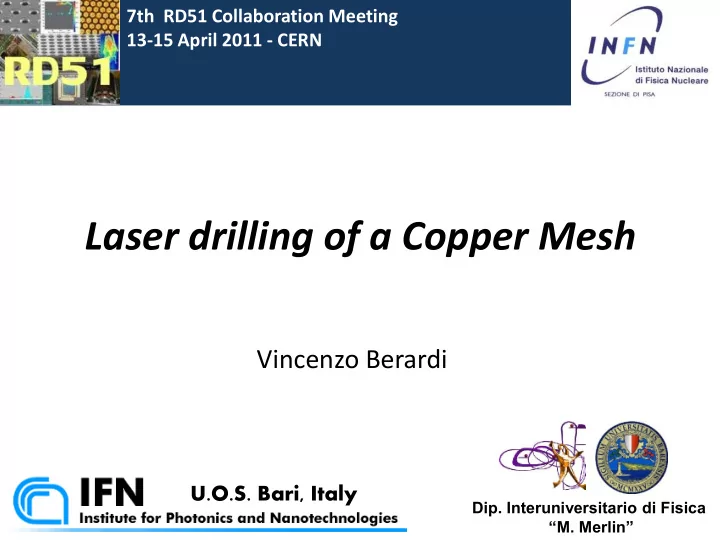

7th RD51 Collaboration Meeting 13-15 April 2011 - CERN Laser drilling of a Copper Mesh Vincenzo Berardi U.O.S. Bari, Italy Dip. Interuniversitario di Fisica “M. Merlin”
Laser Ablation Definition Laser ablation is the process of removing material from a solid surface by irradiating it with a laser beam. At low laser flux, the material is heated by the absorbed laser energy and evaporates or sublimates. At high laser flux, the material is typically converted to a plasma. Usually, laser ablation refers to removing material with a pulsed laser Vincenzo Berardi - 14 April 2011 CERN – 7° RD51 Collaboration Meeting
Timescales of the laser ablation process fs ps ns µs energy absorption by free electons electron - lattice energy transfer ablation by phase explosion or evaporation Thermal diffusion Melting and resolidification Mazur et al. Nature Materials 2 , 217 (2002) Vincenzo Berardi - 14 April 2011 CERN – 7° RD51 Collaboration Meeting
Laser drilling strategies for high accuracy Trepanning optic for helical drilling F. Dausinger et al., Springer (2004) Vincenzo Berardi - 14 April 2011 CERN – 7° RD51 Collaboration Meeting
Cu Parameters Material Density Thermal Melting Vaporization (g cm -3 ) Conductivity point temperature (W m -1 K -1 ) (°C) (°C) Copper Metal 8.94 400 1084 2562 Finding optimal laser process parameters (pulse duration, wavelength, fluence, drilling strategy) Copper oxide around the hole walls (post process cleaning could be required) Advantages Flexible technology: complete control of the hole morphology (taper, diameter) and geometry (density of the holes mm -2 , distribution) Vincenzo Berardi - 14 April 2011 CERN – 7° RD51 Collaboration Meeting
Microchip laser fiber amplifier (100 ps) dichroic mirror, Q-switched output HR @ 1064nm, spin on glass AR @ 808nm glue Quasi-monolithic Q-switched microchip laser f=30mm f=20mm fiber coupled coating, diode laser, laser crystal, 0.55 m PM-DC SESAM 808nm, 1W mm 5 Watt Pump diode mm 18 Watt 1.5 m PM-PCF Yb-doped photonic crystal fiber Vincenzo Berardi - 14 April 2011 CERN – 7° RD51 Collaboration Meeting
CNR-IFN Bari - Laser materials processing lab Short pulse 100 ps fiber laser Specifications Wavelength 1064 nm Pulse duration 100 ps Repetition rate ≈ 100 kHz Collaboration 100 μ J Pulse energy max. Average power 10 W Peak power max. 1 MW CNR-IFN Bari FSU JENA Vincenzo Berardi - 14 April 2011 CERN – 7° RD51 Collaboration Meeting
Post process Analysis • Electron Microscopy - Field Emission • EDS (EDX) (Energy Dispersive X-ray Spectroscopy) Vincenzo Berardi - 14 April 2011 CERN – 7° RD51 Collaboration Meeting
A look at the surface(s) 5 m m 18 m m 5 m m layer front surface 5 m m layer back surface Vincenzo Berardi - 14 April 2011 CERN – 7° RD51 Collaboration Meeting
EDS Metallic surface Vincenzo Berardi - 14 April 2011 CERN – 7° RD51 Collaboration Meeting
Single layer drilling Array of 400 x 400 holes 1cm x 1 cm (post processing 20 x 20) 5 m m Average Pitch (center to center) d = 24 m m 18 m m Average size (diameter) = 13 m m Laser Power = 500mW Overall processing time = 2 hours and 30 mins Vincenzo Berardi - 14 April 2011 CERN – 7° RD51 Collaboration Meeting
Single layer drilling 5 m m 18 m m Diameter Pitch ( m m) ( m m) 5 m m layer 13.10 (0.8) 24.50 (1) #8_02Mar_5up_laser_entry01 #8_02Mar_5up_laser_entry02 18 m m layer 7.50 (0.8) 23.55 (1) #8_02Mar_5up_laser_entry03 #8_02Mar_5up_laser_entry04 Vincenzo Berardi - 14 April 2011 CERN – 7° RD51 Collaboration Meeting
Double layer drilling 18 m m 1 5 m m 2 5 m m 3 #9_02Mar_5up_laser_entry01 #9_02Mar_5up_laser_entry03 18 m m 4 #9_02Mar_5up_laser_entry02 #9_02Mar_5down_laser_exit01 Vincenzo Berardi - 14 April 2011 CERN – 7° RD51 Collaboration Meeting
Double layer drilling 18 m m 1 5 m m 2 5 m m 3 #9_02Mar_5down_laser_exit02 #9_02Mar_5down_laser_exit03 18 m m 4 #9_02Mar_5down_laser_exit04 #9_02Mar_5down_laser_exit05 Vincenzo Berardi - 14 April 2011 CERN – 7° RD51 Collaboration Meeting
EDS Hole edge 5 m m 18 m m Between holes Vincenzo Berardi - 14 April 2011 CERN – 7° RD51 Collaboration Meeting
EDS Near Hole edge 5 m m 18 m m Hole edge Vincenzo Berardi - 14 April 2011 CERN – 7° RD51 Collaboration Meeting
Summary Cu meshes can be drilled to obtain 12-14 micron diameter holes with a pitch of 20-25 microns (focusing spot down to < 10 μ m) Only percussion drilling can be reliably used and Oxide formation can be limited but not avoided by flowing inert gas on the surface. Contamination can be reduced by changing the geometry as follows 18 m m 5 m m 18 m m Vincenzo Berardi - 14 April 2011 CERN – 7° RD51 Collaboration Meeting
IFN Group Antonio Ancona CNR-IFN, Staff Teresa Sibillano CNR-IFN, Staff Francesca Di Niso Dept of Physics, PhD student INFNGroup Gabriella Catanesi INFN, Staff Vincenzo Berardi Dept of Physics, Staff Emilio Radicioni INFN, Staff Vincenzo Berardi - 14 April 2011 CERN – 7° RD51 Collaboration Meeting
Recommend
More recommend